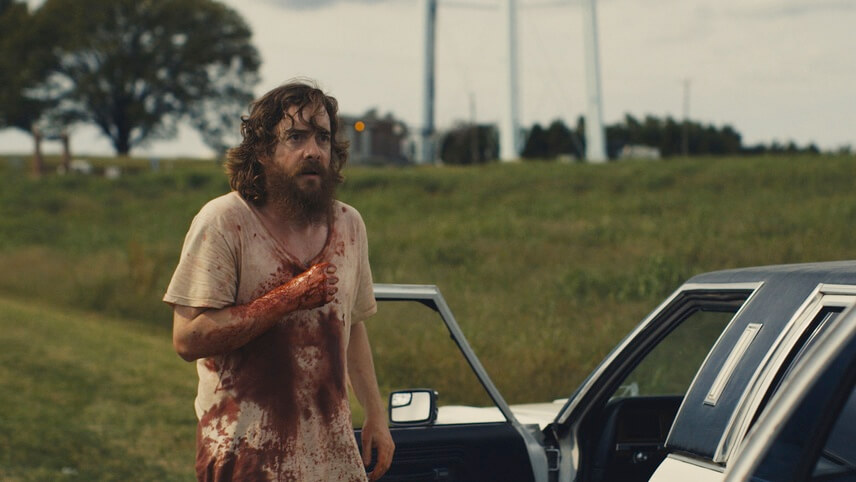BLUE RUIN. A thriller where surprises are hidden in the details

In “Nothing Funny,” Adas Miauczyński referred to his car as an orange corpse. I wouldn’t mind if the Polish translation of “Blue Ruin” borrowed this joke from Koterski’s film – the color may not be the same, but “Błękitny trup” (Blue Corpse) also sounds proud. However, it may refer not only to the main character’s car but also to the character himself – someone damaged, defeated, living in poverty, detached from reality and other people. Dwight (played by the incredible Macon Blair) looks perpetually exhausted, disheveled, and, above all, incapable of violence. But when he learns that Wade Cleland is about to be released from prison one day, he revs up his beat-up car and sets out to seek revenge.
It’s difficult to write about Jeremy Saulnier’s thriller without delving further into the plot – it is surprising cinema, although the surprises lie in the details, not necessarily in the overall outline of the story. Nevertheless, I will cautiously meter out information about the further course of action.

The plot revolves around Dwight’s conflict with the released Wade and his family, which is as dangerous as the ex-convict himself. They grab weapons without hesitation, and there is no mercy until either they or Dwight are dead. Dwight himself realizes a bit late that his sister and her two daughters could also become victims. The sister, understanding her brother’s desire for revenge, acknowledges that he is too weak for the fight. The viewers see this too; Dwight seems the least suitable candidate for an action movie hero. He is as clumsy as possible, not only physically but also intellectually. He can’t anticipate the consequences of his actions, and each decision he makes seems driven by impulse rather than deep reflection. However, all of this works to the advantage of “Blue Ruin,” which transforms from a simple revenge film into a dark poem about the consequences of the need for a bloody settling of scores.
Even a very bloody one – in Saulnier’s film, a knife is thrust so deeply into the head that the victim’s eye whites are flooded with blood. Another time, a rifle shot takes off half a man’s face. The director doesn’t try to soften these scenes with black humor, although “Blue Ruin” is not devoid of it, especially when Dwight acts contrary to accepted norms.
Similar to the best films of the Coen brothers, it’s stupidity and lack of imagination that determine the humor of the story and characters, but Saulnier’s world is not in any way exaggerated.
Realism contrasts well with the otherness of the main character, and the essence of revenge, especially one stemming from a multi-generational conflict. It’s not worth delving into its roots; what matters is only to hate not only the killer but also his family. Attempts at any understanding will come to nothing because some relative will vent their dissatisfaction and want to settle scores. Thus, “Blue Ruin” resembles Jeff Nichols’ debut “Shotgun Stories,” but while that film focused on the sociological drawing of the battle between two families, avoiding violent scenes, Saulnier’s work is a slowly developing, full-blooded thriller.

However, there are scenes, often just shots, suggesting a completely different cinema, less literal, revealing the hidden order of the world. Dwight is already such a wreck of a man that we can’t see in him what seems most obvious when it comes to revenge – hatred. There is determination, pain, sadness, and fear, but hatred seems absent. He even gives the Clelands a chance to end the devastating feud, which contradicts the image of a lone avenger who must take revenge at all costs. If juxtaposed with images of nature against which Dwight is constantly portrayed, a simple conclusion is not hard to come by.
Just as at the beginning, the sea is calm, and nothing disturbs the existence of the main character, later the weather becomes increasingly treacherous – it is evident when Dwight drives through the forest in the morning fog and later when the wind scatters his hair in all directions after the first attack, and especially in the finale, during a thunderstorm with lightning and in the images of what it left behind.
Saulnier’s character is like an element that cannot be stopped, and hatred, like other feelings, is not inherent in his nature.
He often behaves in an incomprehensible way, but it does not contradict his character. At times, he seems inhuman due to his aversion to contact with others – he can’t even talk to his sister, as if he had forgotten how to do it. Focused only on the goal, he has flashes of how a regular person should behave, but even a meal eaten in a roadside bar quickly rejects, unaccustomed to normal eating. We don’t see the actions of a man because Dwight gave up on that a long time ago. He has a family to protect and a friend to turn to for help, but under the clothing, only a living corpse remains, devoid of the will to live but not the will to fight. Perhaps that’s why his vendetta appears as something… natural, beyond good and evil, a process over which he himself has no influence?

